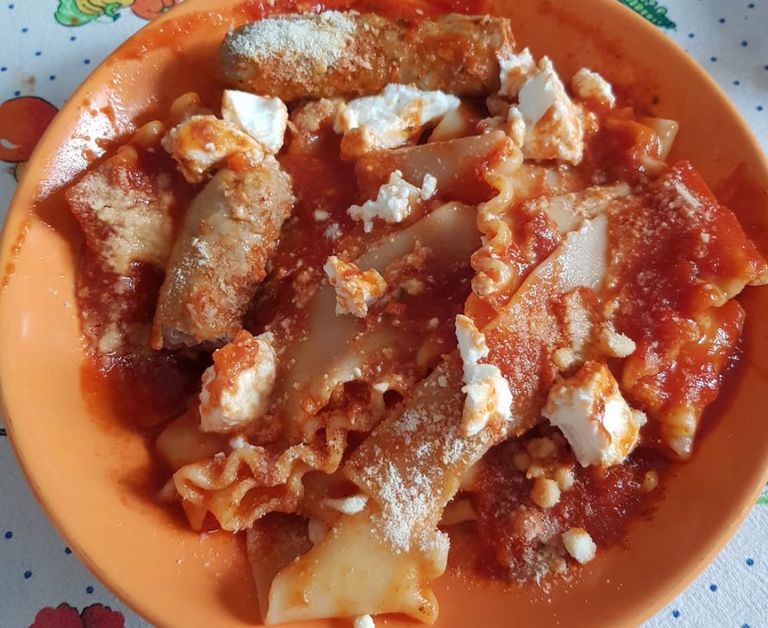
Don't translate this recipe literally, because you'll end up with something not very pleasant.
In this sense cacate, in Italian, does not mean a bowel movement but a quick recipe, made quickly as in this case and with the ingredients we have at hand.
Having made this clarification, which is essential on the other hand, to avoid misinterpretations, let's go to the recipe and the ingredients, as usual, step by step.
It is actually a typical Christmas dish, present mainly in the Modica area in the province of Ragusa, but also very well known in western Sicily. The name, “Lasagna cacate”, may seem a bit strange, but the taste is definitely something different.
In Palermo, lasagna “cacate” is the traditional dish for New Year's Day.
SEPARADOR
No hagan la traducción literal de esta recetas, porque les va salir algo no muy agradable.
En este sentido cacate, en italiano, no significa ninguna evacuación intestinal sino una receta veloz, hecha a la ligera como en este caso y con los ingredientes que tenemos a mano.
Hecha esta aclaración, indispensable por otro lado, para evitar malas interpretaciones, vamos a la receta y a los ingredientes, como de costumbre, paso por paso.
En realidad es un plato típico navideño, presente principalmente en la zona de Modica en la provincia de Ragusa, pero también muy conocido en el oeste de Sicilia. El nombre, “Lasaña de cacate”, puede parecer un poco extraño, pero el sabor es definitivamente algo diferente.
En Palermo, la lasaña “cacate” es el plato tradicional del día de Año Nuevo.
Recipe for 6 people / Receta para 6 personas
Ingredients:
500 g flour (or 12 ready-made cannelloni)
4 eggs
40 ml extra virgin olive oil
20 ml water
a pinch of salt
SEPARADOR
500 g de harina (o 12 canelones listos para usar)
4 huevos
40 ml de aceite de oliva virgen extra
20 ml de agua
una pizca de sal
Preparation
(60') + 150' cooking time. / (60') + 150' de cocción.
The flour should be mixed with the whole eggs and a pinch of salt dissolved in warm water.
The resulting dough is spread on a pastry board and cut into strips three or four centimetres wide and boiled in moderately salted water.
Meanwhile, prepare the ragout with 1.2 kilos of pork or beef, 300 grams of tomato extract, 1 onion, 100 grams of lard, red wine and salt.
The meat should be tied with thread and browned in lard until perfectly golden.
The meat is set aside and the chopped onion is fried in the fat obtained during cooking.
To the resulting sauce we add the extract dissolved in a little water and let everything mix a little.
Then we add about a litre of water and add the meat.
Everything should be cooked for about two and a half hours on a low heat, adding a glass of red wine and salt halfway through cooking.
Once cooked, the piece of meat should be separated from the sauce thus obtained. In many cases, this recipe requires cutting the meat into slices, seasoning it with this sauce and serving it.
In this case the ragù is used to season the lasagna.
In fact, once the lasagna is cooked, it is necessary to dip it in the ragù pan and season it with cheese, sprinkle with ricotta and season with freshly ground black pepper.
SEPARADOR
La harina se debe mezclar con los huevos enteros y una pizca de sal disuelta en agua tibia.
La masa resultante se extiende sobre una tabla de repostería y se corta en tiras de tres o cuatro centímetros de ancho y se hierve en agua moderadamente salada.
Mientras tanto, preparar el ragú con 1,2 kilos de carne de cerdo o ternera, 300 gramos de extracto de tomate, 1 cebolla, 100 gramos de manteca de cerdo, vino tinto y sal.
La carne debe atarse con hilo y dorarse en manteca hasta que quede perfectamente dorada.
La carne se reserva y se fríe la cebolla picada en la grasa obtenida durante su cocción.
Al sofrito resultante le añadimos el extracto disuelto en un poco de agua y dejamos que se mezcle todo un poco.
Luego añadimos aproximadamente un litro de agua y añadimos la carne.
Todo debe cocinarse durante aproximadamente dos horas y media a fuego lento, añadiendo un vaso de vino tinto y sal a mitad de la cocción.
Una vez cocido, el trozo de carne debe separarse de la salsa así obtenida. En muchos casos, esta receta requiere cortar la carne en rodajas, condimentarla con esta salsa y servirla.
En este caso el ragú se utiliza para condimentar la lasaña.
De hecho, una vez cocida la lasaña, es necesario sumergirla en la sartén del ragú y condimentarla con queso, espolvorear con ricotta y condimentar con pimienta negra recién molida.
Some curiosities about the recipe. / Algunas curiosidades sobre la receta.
The Christmas season can be understood not only in the strictly religious sense linked to the birth of the Christian God, or in the purely folkloric sense linked to the celebrations held in various cities such as the “Living Nativity Scenes”, but also from the culinary point of view linked to typical island recipes.
Popular imagination, combined with the magnificence of the dishes offered here, which very often constitute a unique dish thanks to the abundance of ingredients used and the high level of elaboration of the recipe, create unique spectacles not only for the palate but also for the eye.
Very often the same recipes can have local variations, but the goodness of the dish is always guaranteed.
SEPARADOR
La época navideña puede entenderse no sólo en el sentido estrictamente religioso ligado al nacimiento del Dios cristiano, o en el puramente folclórico vinculado a las celebraciones que se realizan en diversas ciudades como los “Belenses Vivientes”, sino también desde el punto de vista culinario vinculado a las recetas típicas isleñas.
La imaginación popular, unida a la magnificencia de los platos que aquí se ofrecen, que muy a menudo constituyen un plato único gracias a la abundancia de ingredientes utilizados y al alto nivel de elaboración de la receta, crean espectáculos únicos no sólo para el paladar sino también para la vista.
Muy a menudo las mismas recetas pueden tener variaciones locales, pero la bondad del plato siempre está garantizada.
These recipes and many others published in # BLURT can be found on my blogs in Italian, English and Spanish. More than 5,000 recipes to give fantasy and color to your table and make a figure worthy of a chef with your guests.

Estas recetas y tantas otras publicadas en #BLURT las pueden encontrar en mis blogs en italiano, inglés y español. Más de 5.000 recetas para darle fantasía y color a tu mesa y hacer una figura digna de un/a chefs con tus invitados.


Y como siempre me despido de todos con un:
And as always I bid you all farewell with a:
